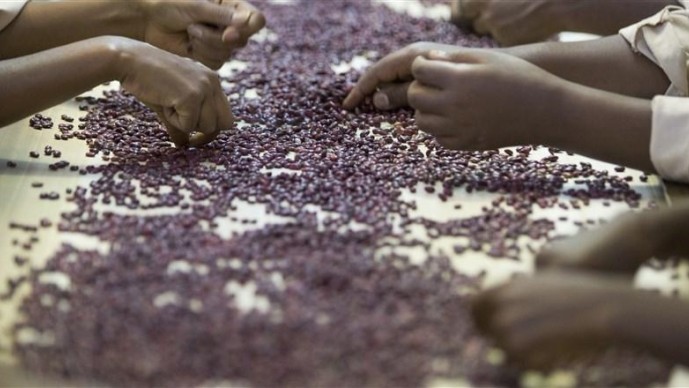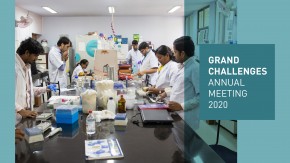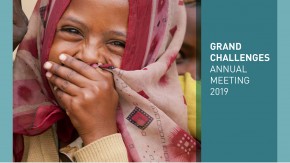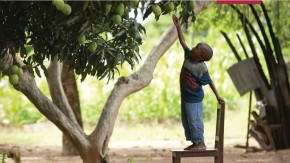The Grand Challenges Family of Grant Programs
- Steven Buchsbaum, David D'Argenio, Mar 11, 2014

"We must know. We will know." This is the mathematician David Hilbert's epitaph, which captures the spirit of impatient optimism that led him over a century ago to define a set of unsolved problems to challenge the field of mathematics. Since then, many different groups have defined "Grand Challenges" to focus attention and effort on specific issues. The US government launched Grand Challenges for the 21st Century, including the BRAIN initiative (Brain Research through Advancing Innovative Neurotechnologies). DARPA launched the Robotics Challenge. And in 2003, the Bill & Melinda Gates Foundation launched the grant program Grand Challenges in Global Health that came to include multiple funding partners, following in 2007 with Grand Challenges Explorations as a complementary, more accelerated grant-making program. These two programs seek to regularly engage the world's brightest minds to solve some of the world's most pressing global health and development problems.
We on the Grand Challenges team at the Gates Foundation often get asked whether there is something special about the Grand Challenges family of programs launched and run by the foundation and its partners. After all, many groups are crowdsourcing innovation to solve defined problems. General Mills has its G-WIN program and GE has an open innovation platform, for instance. Is there anything unique about programs within the Grand Challenges family?
We have three answers. The first answer is that the Grand Challenges family of programs is focused on harnessing a global community of innovators to create new solutions - technology innovations as well as social and business innovations - to improve the health and accelerate the development of those most in need around the globe.
The second answer is that the Grand Challenges family is all about partners. Each Grand Challenges program can be viewed as an experiment in the Grand Challenges approach, and funders are carrying out these experiments both in partnership and independently, creating an expanding network of research partnerships spanning diverse topics.
One particularly rich example of this partnership network in action is the set of programs to improve maternal and child health launched over the last four years:
- Gates Foundation's Grand Challenges Explorations topics, one seeking to Create New Technologies to Improve the Health of Mothers and Newborns and one to Explore Nutrition for Healthy Growth of Infants and Children;
- USAID and partners' Saving Lives at Birth: A Grand Challenge for Development;
- Global Alliance to Prevent Prematurity and Stillbirth (GAPPS) and the Gates Foundation's Grand Challenges in Global Health: Preventing Preterm Birth;
- Grand Challenges Canada's Saving Brains;
- Gates Foundation's Grand Challenges in Global Health: Discover New Ways to Achieve Healthy Growth;
- Grand Challenges Brazil's Reducing the Burden of Preterm Birth;
- Grand Challenges India's Achieving Healthy Growth through Agriculture and Nutrition; and launched most recently,
- Gates Foundation's Grand Challenge Explorations topic Explore New Ways to Measure Fetal and Infant Brain Development
The third answer, as demonstrated by this set of programs on maternal and child health, is that the Grand Challenges family of funders and researchers together can be greater than the sum of the individual members – and that sharing the Grand Challenges brand helps make this possible. We recently held the first Grand Challenges Learning and Evaluation Meeting, bringing together nearly 80 current and prospective Grand Challenges funders and practitioners from 28 organizations and 12 countries. The goal of the two-day meeting was to learn from each other.
During the meeting, participants described progress to date and shared lessons from a decade of grant making, including highlighting what went well and what went less well in designing effective requests for proposals, managing projects, and measuring success. The meeting highlighted just how many different experiments in the Grand Challenges approach have been run, and it was hard to avoid the conclusion that there is now a global movement with self-sustaining momentum.
But how best to capitalize on this momentum? Based on discussion at the meeting, there are likely to be a number of ways to enhance the Grand Challenges approach by further aligning and synchronizing partners' efforts. And with an enhanced partnership network, this year's 10th anniversary Grand Challenges meeting provides an excellent opportunity to shape the next phase of the Grand Challenges approach for funding innovation with impact.



